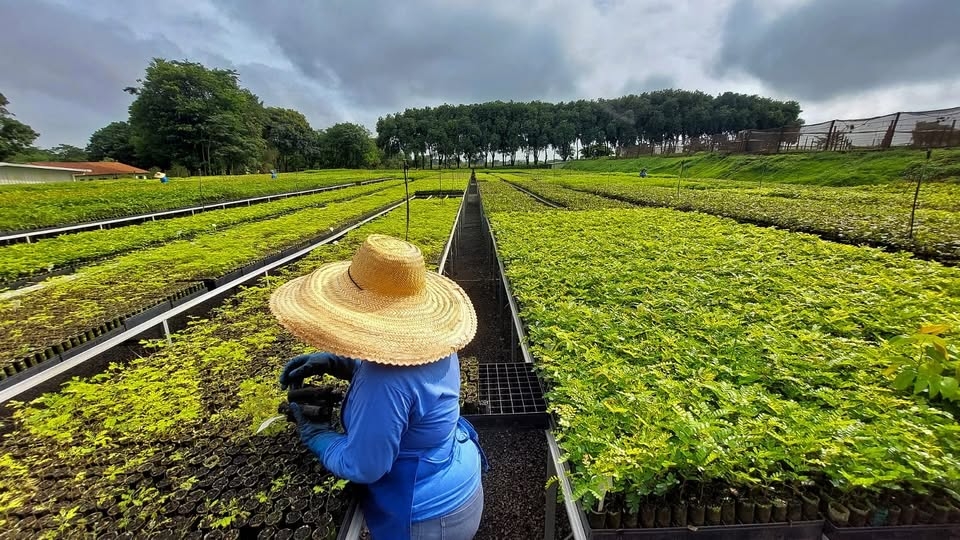


Restoration is carried out using native Brazilian species grown at the Bioflora seedling nursery in Piracicaba. The nursery is supported by PIPE-FAPESP and has been part of Re.green since 2021 (image: Re.green)
Published on 10/28/2025
By Elton Alisson | Agência FAPESP – Over the past 26 years at the helm of the Environmental and Agricultural Adaptation Program for Rural Properties at the Laboratory of Ecology and Forest Restoration (LERF) of Luiz de Queiroz College of Agriculture at the University of São Paulo (ESALQ-USP), Professor Ricardo Ribeiro Rodrigues and his team have managed to reach the milestone of more than 60,000 hectares of forest areas undergoing recovery in Brazil.
However, according to the scientist, this achievement, which represents one of the largest and longest-running forest restoration experiences in Brazil, falls far short of the total area that needs to be reforested in the country.
"The 60,000 hectares of forest that we've managed to restore across the country is very significant for our program, but when we consider the scale of Brazil, it's very little. The country needs to recover 12 million hectares of forest. Through the program, we've only achieved 0.5% of that goal," said Rodrigues in a lecture at the Brazil-France Forum, "Forests, Biodiversity, and Human Societies", which took place on October 1 and 2 in the FAPESP auditorium.
In order to try to increase the scale of forest restoration in Brazil, Rodrigues partnered with Brazilian scientists experienced in the field and joined a proposal by a Brazilian startup founded by investment funds such as Lanx Capital (owned by Marcelo Medeiros and Marcelo Barbará), BW (the family office of the Moreira Salles family, a leading player in the Brazilian financial sector since the 1970s), Gávea Investimentos (owned by former Brazilian Central Bank president Armínio Fraga), and Dynamo three years ago.
The company, named Re.green, aims to restore one million hectares of the Atlantic Forest, the most degraded biome in the country, and the Amazon, thereby capturing 15 million tons of carbon per year.
"I joined the initiative, along with colleagues such as Professor Pedro Brancalion [also from USP], and took the best members of my team with me," he said.
According to Rodrigues, the focus in the Amazon is on the "Arc of Deforestation," an area of 500,000 square kilometers where most deforestation occurs. It extends from the west of the state of Maranhão in the Northeast of Brazil through parts of the states of Pará, Rondônia, and Acre in the North and Mato Grosso in the Midwest. "We intend to transform the Arc of Deforestation into the Arc of Restoration," said Rodrigues.
One way the startup remunerates its investors is through selling carbon credits sequestered by reforested areas.
"We calculate how much carbon each forest restoration accumulates and sell this additionality," Rodrigues explained.
This calculation is based on the methodology used in a project supported by FAPESP and coordinated by Brancalion. Rodrigues was one of the project's principal investigators. In it, they assessed the level of carbon storage in restored forests under different reforestation models and conditions.
To conduct the study, the researchers analyzed 800 forest plots spanning the Atlantic Forest and sampled 70,000 trees belonging to 1,200 species. The results of the study indicated that degraded forest areas accumulate carbon at nearly the same rate as conserved forests.
"That's why it's very interesting to encourage this type of forest restoration for economic purposes, as we call it, because they allow for the accumulation of a lot of carbon," Rodrigues said.
Use of native species
To carry out the projects, the startup buys or leases farms with land that was originally forest but was converted into pasture. The startup then compensates the owners for allowing these areas to be used for restoration.
A model developed in Rodrigues's laboratory determines the optimal restoration model for each area.
"For each farm, we have the possibility of applying 60 different restoration models, taking into account factors such as natural regeneration potential, carbon storage, commercialization of sustainably harvested wood products, provision of ecosystem services, and level of mechanization," Rodrigues explained.
Restoration is carried out using native Brazilian species, such as the pink jequitibá (Cariniana legalis), jacaranda-da-bahia (Dalbergia nigra), ipê-roxo-de-bola (Handroanthus impetiginosus), and pau-brasil (Paubrasilia echinata). These species are cultivated in the Bioflora seedling nursery in Piracicaba. The company received support from FAPESP's Innovative Research in Small Businesses Program (PIPE) (read more at https://agencia.fapesp.br/27167).
The nursery, which produces 2.5 million seedlings of native Brazilian species per year, was founded in 1998 by a team now part of the startup led by Rodrigues. Re.green incorporated the nursery in 2021. "We were able to estimate the carbon stock levels for each native species we grow, at different ages and in different environments, in order to show that forestry can also be an interesting source of return for investors in these forest restoration projects," Rodrigues said.
The company currently has 16,500 hectares of land undergoing restoration and 16,900 hectares under conservation. The first restoration project in the Amazon began in October 2023 on a property with 8,427 hectares of restorable land in the states of Maranhão and Pará. "This is the largest continuous area restoration project in South America," Rodrigues said.
Initial analyses of ongoing project results indicate that the company's restoration models have made it possible to accumulate 14% more carbon stock in reforested areas than initially estimated.
Source: https://agencia.fapesp.br/56284